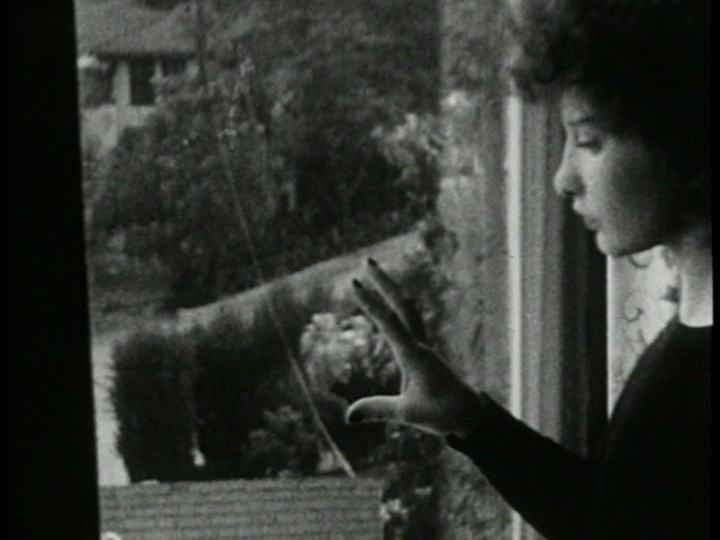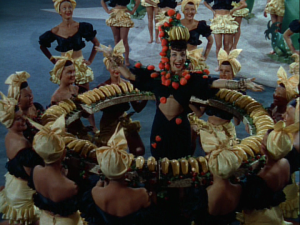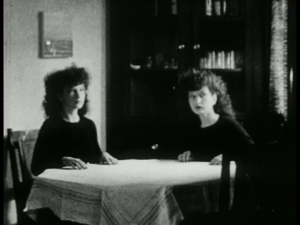Teaching Meshes of the Afternoon
Sarah Keller
Perhaps unfairly, I think of Maya Deren’s Meshes of the Afternoon (1943) as the center of a wheel with many spokes on a conveyance that takes a body just about any worthwhile place it might wish to travel. I don’t expect every student to be transported by it, but I do try to highlight the many worthwhile stops along the course it runs. Usually I teach it in undergraduate classes where, more often than not, students have had very limited if any exposure to experimental films—or films by women, for that matter—or black-and-white films from any year before the new millennium, or etc., etc., etc. So that’s the potentially unfair part of it: the film has to carry the freight of representing a good deal of film history that the students might otherwise miss. But as I said, this wheel has many sturdy spokes and travels far.
Before the class begins to examine the spokes radiating out from Meshes of the Afternoon’s center, I find it important to anticipate a principal objection that gets raised when I show experimental films of any kind in an introductory film course. It takes a few different forms, but generally involves skepticism. This reaction has to do with a student’s fear that the film is difficult or willfully (and confusingly) mysterious and that they just don’t and won’t get it—that it has a single, clear meaning that is hidden from them and they risk sounding stupid if they talk about it. Frequently, doubts about the value of non-linear, non-causal, non-narrative forms accompany this response. The question, to put it plainly, is something like: “what’s the point of a film like this?”
So keeping in mind that this will come up or is somewhere hovering over the class as we watch the film together, I begin by asking how we might start to engage with this film, and why should we engage with it. Where ought one to begin in a film where beginnings and ends are indefinite? To answer these questions, we start to examine some of the spokes more closely.
We might start with just a few brief statements of fact:
Meshes of the Afternoon was made in 1943 for a few hundred dollars (about $275) in the first months of Maya Deren’s marriage to already accomplished filmmaker Alexander Hammid. It was originally silent, but Deren added a soundtrack to it in 1959. Immediately after making it, Deren drafted an essay entitled “Cinema as an Art Form,” in which she addressed what she had been trying to achieve in this, her first film, and in her film practice more generally.
The implications of these few facts are far-reaching:
First, they signal an amateur (Deren liked this word to describe an aspect of her work because of its etymological relation to a lover) and a do-it-yourself aesthetic. This provenance puts the film into the realm of cinema outside of commercial/narrative interests on the one hand and strictly documentary/social/political interests on the other. Deren talks about this issue in “Cinema as an Art Form,” an essay I like to assign with Meshes of the Afternoon (a pairing representing an early foray into filmmaking and writing about film).[1] Having this point of reference serves as a touch point for aspiring filmmakers in the class: it serves as encouragement for thinking of cinema as something any inspired soul might take up. It also initiates a sense of film history as subject to a range of influences outside of the mainstream.
Second, these few facts underline the notion of cinema both as a singular creative act by a visionary artist and, simultaneously, as a collaborative process. Deren consistently credited the creative labor of her collaborators as part of her films’ provenance, and Meshes of the Afternoon rightly acknowledges Hammid’s part. This recognition offers an intervention in the history of cinema shaped by auteurist approaches, to allow the influence of multiple personnel in filmmaking. Hammid plays a considerable role here, as does Teiji Ito, whose score was added about fifteen years after Meshes of the Afternoon was finished. This emphasis on collaboration diminishes the perception that the director is the singular helmsperson for a film project. At the same time, the small number of persons working on the film points to the possibility of controlling the outcome of a film made as a work of art rather than as a commercial product with many producers whose thumbs are in the creative pie. Deren and Hammid wrote, directed, acted in, and filmed it together, without recourse to studio concerns. Meshes of the Afternoon underlines the collaborative nature of film production, but in an experimental context, where interestingly the need for collaboration and cooperation is diminished.
Third, this short set of facts about the film offers an insight into the unusual feminist dynamics of the film. Meshes of the Afternoon has sometimes been (rather perversely) described as Deren and Hammid’s honeymoon home movie. For her whole working life, Deren struggled against the norms of a male dominated industry and art form. Does the relationship between the woman in the film (played by Deren) and the man in the film (played by Hammid) reflect her vocational difficulties?[2]
Fourth, the year the film was made points to a number of ways we might contextualize Meshes of the Afternoon in film history and in history more broadly. At a minimum, I try to connect it to film noir, women’s films, and art movements of the moment. I usually show still images or short clips to illustrate the stylistic connections among these forms. Or I contextualize the film and its mid-war context by considering what, in terms of its historical moment, it is not. For instance, I sometimes show the number “The Lady in the Tutti Frutti Hat” from The Gang’s All Here (which was made the same year, 1943) to launch a study in contrasts and to show the cinematic intervention Deren is making in her moment. Deren once wisecracked that she spent on her films what Hollywood spent on lipstick: in The Gang’s All Here, I’m pretty sure the lipstick budget (and the prop budget: cf. bananas) must be significantly higher than Deren’s whole film. The contrast inspires discussions about gender dynamics, production values, and political investments.
Fifth, the change from silent to sound in the film’s own history underscores Deren’s working method and perspective on her process. In short, she felt that her work was perpetually ongoing—quoting poet Paul Valéry on this matter, she described her films as “never completed, but merely abandoned.”[3] The way she revisited Meshes of the Afternoon and transformed it from silent to sound illustrates her thinking about the open-ended nature of film form and creative labor.
And finally, as I mentioned, I like to assign “Cinema as an Art Form” with the film because it was written so soon after Deren and Hammid made Meshes of the Afternoon and therefore encapsulates a lot of the ideas she was working through in the film. The issues she raises here both illustrate the ideas afoot in the film and galvanize her thinking for future projects. This pairing represents the marriage of film production and film theory in miniature, and therefore serves as an excellent way to introduce a practical value and application for theory. We talk about it in terms of how Meshes of the Afternoon might be engaging these issues specifically:
- What can film do as an art?
- What is the role of reality in a creative film project?
- Why does Deren emphasize the film experience? What experience do you find encapsulated by Meshes of the Afternoon?
While we discuss these issues, I periodically draw attention to a key passage or two to ground our observations in the text itself. (For instance: “When we agree that a work of art is, first of all, creative, we actually mean that it creates a reality and itself constitutes an experience.”[4])
While Meshes of the Afternoon affords a robust introduction to this set of key issues for cinema studies more generally, what really works on the handful of converts to experimental cinema that it inspires is the film itself. The film apportions a range of access points for its viewers: it embraces circularity and repetition (in its overall structure), assays the expressive capacities of the camera (especially movement: for example in the sequence repeated with variations of Deren ascending the interior staircase), and mobilizes post-production techniques to effect a fantasy of multiplying subjects, bringing non-contiguous spaces together through the magic of editing (e.g., the famous steps taken across multiple spaces). While the non-continuity and alternative narrative structure present a challenge to a lot of students, if we start with simply what we’ve observed, and then try to come up with one other thing in the film that seems to relate to it in some way, it soon becomes a dynamic network of associations and ideas.
For example, we might start with the first images: an arm descends into the frame and deposits a flower on the sidewalk. We might notice that it is not a real arm (it helps to look at the clip or a still of it for anyone who missed it).[5] Then we try to think of other things that are not real (shadows, mirror-faced people, the flower, the status of the multiple women who assemble in the house, etc.). We make a list together of how these similar items relate to each other. We think about the associative properties of the objects and ideas that circulate in the film. Because this emphasis on association is one of the film’s strategies for the kinds of meanings it effects, we spend some time coming up with these mini-networks, drawing them as a cluster diagram with a central idea in the center so that we can start to group the ideas without limiting them to one trajectory. I like to have them do this in smaller groups and then share their diagrams by drawing them on the board so we can all see them, add to them, and argue for how the groupings should come together. Then we draw conclusions about what the film is saying about the relationship among these similar kinds of images and ideas.
On a personal note, I love teaching Meshes of the Afternoon. As much as I have thought about it, written about it, seen it, it still feels like it holds the mysterious energy of a genuine work of art (as Deren described it, there are points in the film where it is “like a crack letting the light of another world gleam through…”[6]). It yields new things every single time for me. The real danger for me in teaching it is that I feel I have many, many things to say and share about it. In fact, any time I teach a film I know very well, I have to put limits on what we cover and set a clear focus for the aims of whatever class I am teaching. Otherwise, I find myself getting off track with all the wonderful details in my long-gathered knowledge about the film’s intricacies and production circumstances. It is important to be mindful of consistently returning to the film itself, where the students might invest in their own viewing of the film and where they might find ready access to “the powerful potentialities of the imaginative experience.”[7]
Sarah Keller is Assistant Professor of Art and Cinema Studies at the University of Massachusetts-Boston. She co-edited the collection Jean Epstein: Critical Essays and New Translations (Amsterdam University Press, 2012), and her book Maya Deren: Incomplete Control (Columbia University Press, 2014) examines the role of unfinished cinematic works by focusing on Maya Deren’s oeuvre. Keller’s current project, Cinephilia/Cinephobia, focuses on the history and theory of love and anxiety in the cinema.
Notes
[1] Maya Deren, “Cinema as an Art Form,” in Essential Deren: Collected Writings on Film. Bruce McPherson, ed. (Kingston, NY: Documentext, 2005): 19-33.
[2] For just one example of Deren’s struggles, see the transcript of her participation in a symposium on poetry and film from 1953, in which poet Dylan Thomas and playwright Arthur Miller both make derisive, sexist jokes about Deren’s contributions to the discussion.
[3] Deren, Publicity materials. Maya Deren Collection, Boston University Mugar Library Special Collections.
[4] Deren, “Cinema as an Art Form,” 22.
[5] Jacqueline Stewart started a complex, highly rewarding discussion of Meshes of the Afternoon with this image in her Introduction to Cinema Studies class at the University of Chicago in 2007, for which I was one of the teaching assistants. I want both to give her credit for this as a workable access point into the film and to note that a lot of my teaching is indebted to the fabulous teachers I’ve encountered in my own education.
[6] Deren, “A Letter” (to James Card, 19 April 1955). In Essential Deren, 192.
[7] Deren, “Cinema as an Art Form,” 23.



